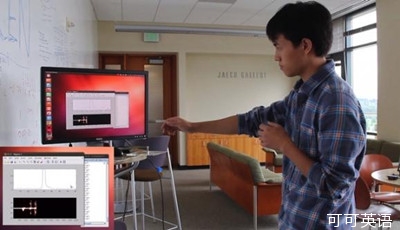Thanks to wi-fi we can watch movies, play games, and check e-mail, from the comfort of the couch.
多虧了wi-fi,我們可以在舒服的沙發上看電影,玩游戲,收發電子郵件。
And soon we may be able to repurpose our wi-fi signals so we can turn on the coffeemaker or turn off the TV with a simple flick of a finger, from anywhere in the house.
而很快我們就可以改變自己的wi-fi信號,或者只需要簡單的輕敲手指就可以在房間的任何角落打開咖啡壺或關掉電視。
Researchers described their prospective system, called WiSee, at the International Conference on Mobile Computing and Networking.
在移動計算與網絡國際會議上的研究人員稱他們這個未來的系統為WiSee。
 The idea is similar in concept to the Xbox Kinect, which uses cameras to recognize a game player’s movements, and translates them into an action onscreen.
The idea is similar in concept to the Xbox Kinect, which uses cameras to recognize a game player’s movements, and translates them into an action onscreen.
這個想法和使用攝像頭識別一名游戲玩家的動作,并將其轉換為屏幕上動作的Xbox Kinect概念如出一轍,
But WiSee works without cameras.
但WiSee可沒有攝像頭。
Instead, it uses the ambient wireless signals put out by our smart phones, laptops, routers and tablets.
取而代之的是它使用由我們的智能手機,平板電腦,路由器及筆記本電腦所發出的無線信號環境。
When we move, we alter the patterns of these wi-fi signals.
當我們動的時候時,我們會改變這些wi-fi信號的模式。
The WiSee receiver detects these disturbances and interprets the motions that caused them, like waving or swinging your fists.
WiSee接收機會檢測這些波動及分析這些運動,比如揮舞或擺動你的拳頭。
Of 900 gestures tested, WiSee could identify 94 percent.
在900種的姿勢測試中,WiSee可以識別其中的94%。
The user assigns a particular motion to a specific gadget—the motion doesn’t have to be the one that works in the real world.
用戶可以分配一種特定的動作給一個特定電器,并不需要在現實世界的運動。
So if all goes well, you may actually be able to punch your lights out.
所以,如果一切順利,你實際上也許能憑空揮拳來關閉電燈。
 The idea is similar in concept to the Xbox Kinect, which uses cameras to recognize a game player’s movements, and translates them into an action onscreen.
The idea is similar in concept to the Xbox Kinect, which uses cameras to recognize a game player’s movements, and translates them into an action onscreen.










